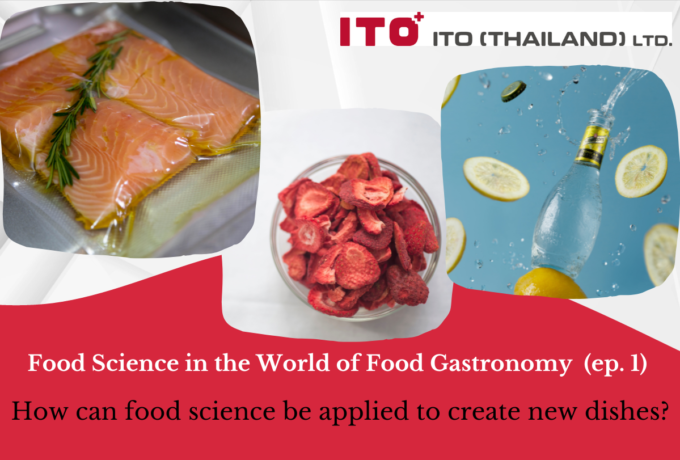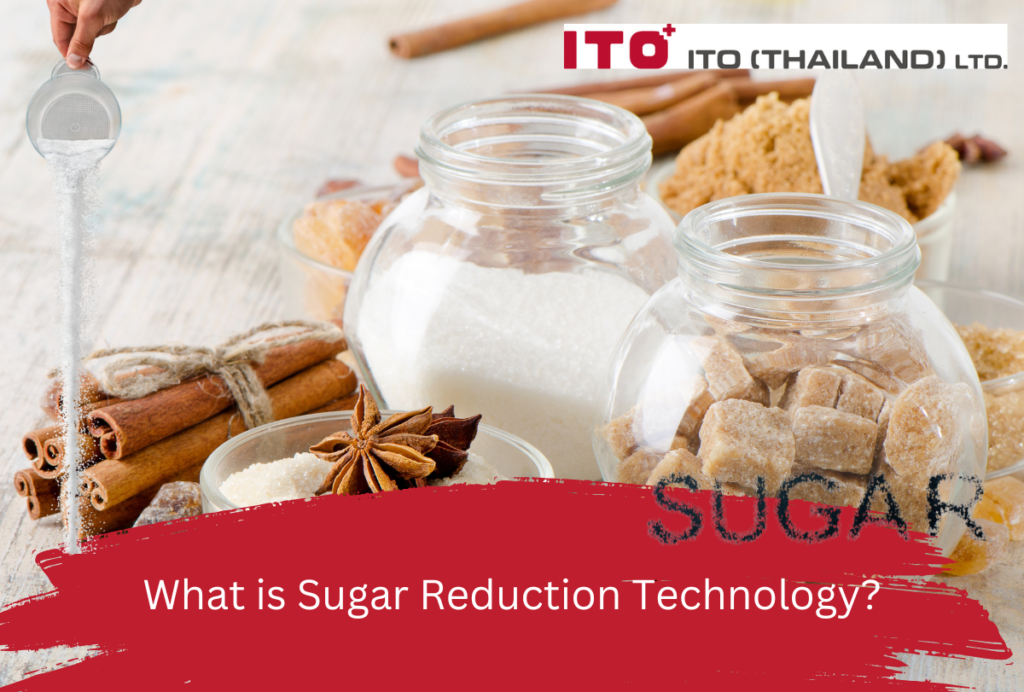ITO Thailand Hygiene Blog
Sugar Reduction Technology
It is undeniable that good food is an important element of a healthy lifestyle. Mindful consumption behaviour has increased, as well as a demand for sugar reduction in food and beverages. A study has found that sugary drinks such as soft drinks, sweetened fruit juice, and energy drinks are responsible for most diet related diseases such as cardiovascular diseases, obesity, and metabolic disturbances (3). So, food manufacturers are putting their efforts to reduce sugar levels with sugar reduction technologies. Glycemic index and its importance, an introduction to sugar reduction technology, the use of enzyme technology as alternative sweeteners, and Reb M to decrease bitterness in natural sweeteners will be discussed in this blog.
Glycemic Index (GI) and Its Importance
First, we need to understand the concept of glycemic index. As previously discussed here, glycemic index is the numeric classification of glycemic response to carbohydrate absorption speed from a standard food (7). In other words, foods with a higher glycemic index are favoured to the development of dietary diseases, as they are able to generate higher fluctuations in blood glucose level (12). So, foods with a lower glycemic index are better for our bodies.
What is Sugar Reduction Technology?
It is the use of enzyme technology to reduce sugar content from its original source and replace it with a low glycemic index (GI) carbohydrate from sugar beet (11). It has been a leading trend in the food industry, accomplished by the use of sweeteners from plants, or converting sugar (fructose, glucose, and sucrose) into prebiotic dietary fibres, with an exquisite sweetness and less unfavourable aftertaste (1).
1.Using Enzyme Technology as Alternative Sweeteners
1.1 Reducing natural sugar from fruit into dietary fibres for fruit juices
Health-conscious consumers are avoiding high fruit sugar levels in juice such as orange juice, as that sweetness can cause various health problems such as type 2 diabetes and obesity (2). So, process engineering and food tech companies have developed and applied non-GMO microorganisms to the process, and the enzymes within the microorganisms can convert sugar into nourishing dietary fibre without affecting texture or vitamin composition of the juice. This method could potentially reduce sugar content by between 20 and 80 percent, which is desirable for health-conscious consumers. This process also provides a great hygienic level as it is fully automated and contamination-free as clean-in-place (CIP) has been utilised (6).
The process is simple. Enzymes from immobilised microorganisms convert sucrose to dietary fibre, glucose to gluconic acid, and fructose to sorbitol (2). In short, sugar content can be lessened with the same texture, sweetness, and product characteristics (2). Moreover, encapsulation technology is applied to the enzymes for an enhanced durability during processing as well (4).
1.2 Lowering sugar contents, and increasing dietary fibres in dairy products
Less sugar content product preference from consumers is presented in the dairy industry as well, and new variations of products such as low-sugar yogurts, or lactose-free milk have hit the shelves. DuPont Nutrition and Biosciences team has developed Nurica, lactose-converting enzyme, to convert lactose in milk into beneficial non-digestible fibres to reduce sugar content and lessen the severity of lactose intolerance (9), a digestive disorder triggered by the inability to digest lactose of human body (10).
Apart from less sugar beverages, high-fibre content dairy products are more likely to be purchased by customers, as consumers have raised their awareness how dietary fibre is healthy, and is associated with blood sugar level balancing, digestion aid, lowering cholesterol and cardiovascular diseases (5).
- Decreasing Bitterness in Natural Sweetener with Stevia (8, 13)
Most artificial sweeteners could not deliver a satisfying sugary taste, as they often contain bitterness and an awkward aftertaste such as Reb A and steviol, however, steviol glycoside Rebaudioside M (also known as Reb M), has no bitterness and can applied to any beverages with 200-350 times sweeter than sugar with zero calorie. It is derived from stevia, so it is recognised as GRAS (Generally recognised as safe), which provides huge benefits to the food industry with recent health-conscious trends. Reb M has a high potential to be used in the food industry, as it has the most sugar-like sweetness with no bitter aftertaste, as well as can contribute to sugar-reduction products. However, it naturally occurs in an extremely low concentration, and not so ubiquitous, so it is expensive and not suitable for the market yet when compared to the plentiful availability and lightly bitter Reb A.
Sugar reduction technology contributes to the health and well-being of consumers. Staying fit and strong is favourable among everyone, so it is important for manufacturers to consider the importance of sugar level in their products prior to launching into the market as previous technologies could not tick all the boxes. We can say that food innovation is the key to satisfy consumer needs.
References
1.Arthur, R. (2021). Shaking up sugar reduction: New tech for beverages. beveragedaily.com. Retrieved February 21, 2023, from https://www.beveragedaily.com/Article/2021/01/29/Innovations-set-to-shake-up-beverage-sugar-reduction
2.Berry, D. (2022). Fruit seen as source of alternative sweetener innovation. Baking Business. Retrieved February 27, 2023, from https://www.bakingbusiness.com/articles/57514-fruit-seen-as-source-of-alternative-sweetener-innovation
3.Brown, C. M., Dulloo, A. G., & Montani, J. P. (2008). Sugary drinks in the pathogenesis of obesity and cardiovascular diseases. International Journal of Obesity, 32(S6), S28–S34. https://doi.org/10.1038/ijo.2008.204
4.Brownell, L. (2022). Kraft Heinz partners with Wyss Institute to make sugar healthier. Wyss Institute. Retrieved February 27, 2023, from https://wyss.harvard.edu/news/kraft-heinz-partners-with-wyss-institute-to-make-sugar-healthier/
5.Devenyns, J. (2020). Novozymes’ enzyme cuts sugar and boosts fiber content in dairy products. Retrieved February 27, 2023, from https://www.fooddive.com/news/novozymes-enzyme-cuts-sugar-and-boosts-fiber-content-in-dairy-products/574689/
6.(2021). Fresh juice production with enzymatic sugar-reduction process. Food and Beverage Technology | Industrial Meeting. Retrieved February 24, 2023, from https://www.industrialmeeting.club/fresh-juice-production-with-enzymatic-sugar-reduction-process/
7.Jenkins, D. J. A., Kendall, C. W. C., Augustin, L. S. A., Franceschi, S., Hamidi, M., Marchie, A., Jenkins, A. L., & Axelsen, M. (2002). Glycemic index: overview of implications in health and disease. The American Journal of Clinical Nutrition, 76(1), 266S-273S. https://doi.org/10.1093/ajcn/76.1.266s
8.Lyubomirova, T. (2022). Zero sugar without compromise: How Reb M can offer a path to tasty sugar-free formulations. Retrieved February 27, 2023, from https://www.dairyreporter.com/Article/2022/10/19/Zero-sugar-without-compromise-How-Reb-M-can-offer-a-path-to-tasty-sugar-free-formulations
9.Manning, L. (2019). DuPont introduces lactose-free enzyme ingredient to lower sugar content in dairy products. Retrieved February 27, 2023, from https://agfundernews.com/dupont-introduces-lactose-free-enzyme-ingredient-to-lower-sugar-content-in-dairy-products
10.(2010). Lactose intolerance: MedlinePlus Genetics. Retrieved February 27, 2023, from https://medlineplus.gov/genetics/condition/lactose-intolerance/
11.Reilly, M. K. (2022). ‘Healthier’ permissible indulgence finds favor. Food Beverage Insider. Retrieved February 21, 2023, from https://www.foodbeverageinsider.com/sugar-reduction/healthier-permissible-indulgence-finds-favor
12.The University of Sydney. (2023). About – Glycemic Index. Retrieved February 21, 2023, from https://glycemicindex.com/about-gi/
13.Wills, B. (2022). Reb M sweetens the appeal of stevia. Natural Products INSIDER. Retrieved February 27, 2023, from https://www.naturalproductsinsider.com/sweeteners/reb-m-sweetens-appeal-stevia
Related Post
-

Food Safety Culture
Food safety culture plays a crucial role in safeguarding the company's reputation, ensuring the well-being of its employees, and providing a safe experience for its customers.
-

New food source safety issues
What are safety issues worth knowing for trendy new food sources like plant-based and insect-based proteins?
-

British Retail Consortium (BRC) Standard
Food safety management systems play a vital role in ensuring the production and distribution of safe and high-quality food products to consumers. With the global food supply chain becoming increasingly complex, food businesses must implement effective systems prioritising safety, quality, and compliance with industry standards. A food safety management system encompasses a set of procedures, processes, and controls designed to identify, prevent, and manage potential hazards at every stage of the food production and supply process. This proactive approach not only safeguards consumers' health but also protects the reputation and credibility of food companies in an ever more competitive market.
-

Food Science in the World of Food Gastronomy (Part 1)
How can food science be applied to create new dishes?
-

FSSC 22000
Food manufacturers must ensure food safety standards and processes. FSSC 22000 is an official certification program for Food Safety Management Systems (FSMS) recognised by the Global Food Safety Initiative (GFSI). This certification scheme offers a set of guidelines and procedures to ensure uniformity, openness, and safety across your entire supply chain. It applies to all companies operating within the food and beverage industry, ranging from farmers to retailers. By fulfilling the necessary criteria and obtaining FSSC 22000 certification, it is demonstrated that the required standards for food quality and implementing effective processes to manage and mitigate risks associated with food fraud, foodborne illnesses, expensive recalls, and other external threats are met.
-

Food Safety Aspects of Artificial Sweeteners
Artificial sweeteners, also known as sugar substitutes, non-nutritive sweeteners, or high-intensity sweeteners, are artificially produced compounds utilised in place of sucrose (table sugar) to add sweetness to food and drinks. Due to their significantly higher sweetness than regular sugar, only a fraction of artificial sweeteners (200 to 20,000 times less) is required to achieve an equivalent level of sweetness. Since the caloric contribution of these sweeteners, when used in such small quantities, is insignificant, they are often referred to as non-nutritive (4).










